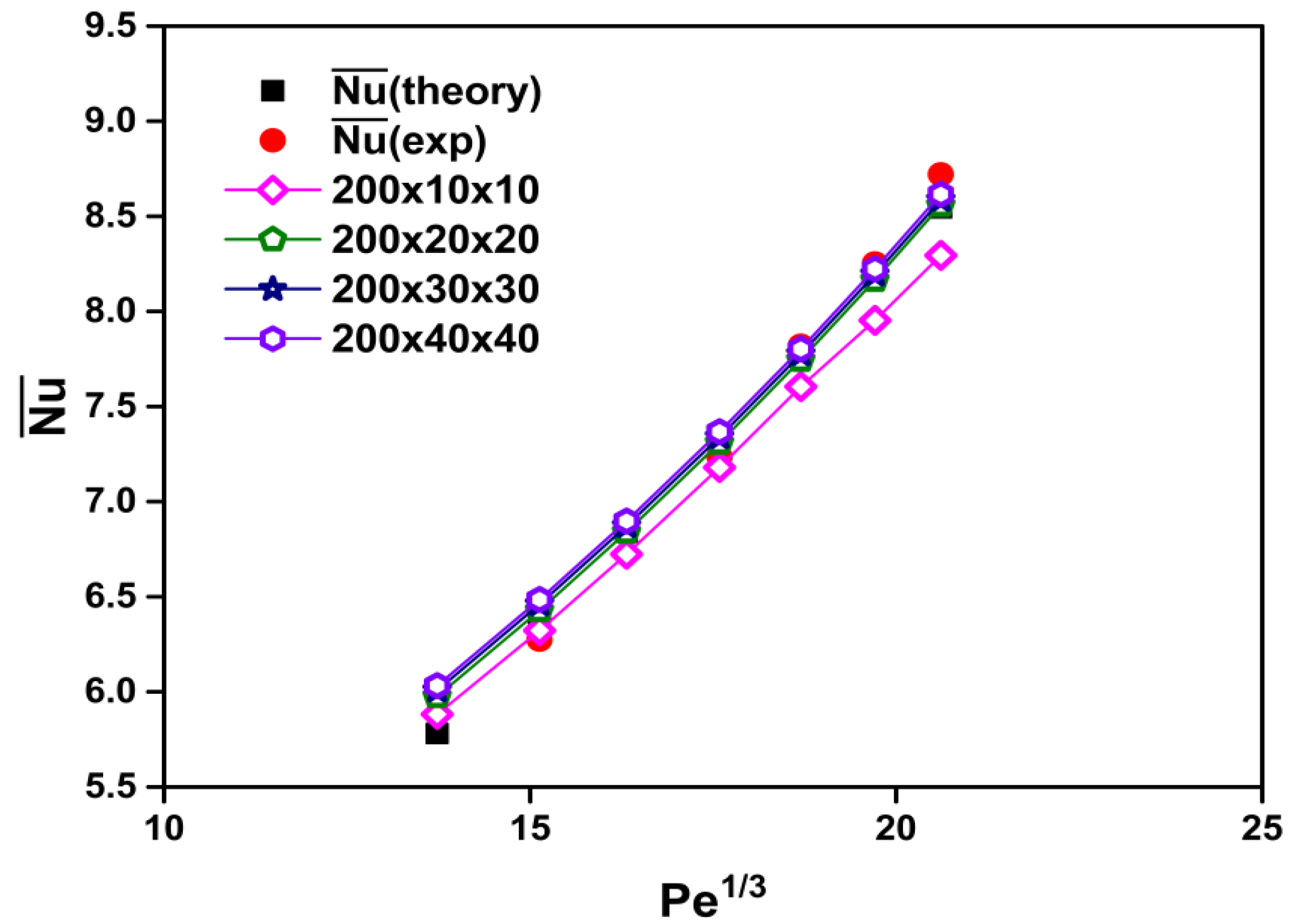Investigation of Laminar Convective Heat Transfer for Al2O3-Water Nanofluids Flowing through a Square Cross-Section Duct with a Constant Heat Flux
Abstract
:1. Introduction
2. Mathematical Modeling
2.1. Assumptions and Governing Equations
2.2. Physical Properties of Nanofluid
2.3. Boundary Conditions
- •
- (1) At the inlet: profiles of uniform axial velocity and uniform temperature Tb,i are used as the inlet velocity and temperature conditions, respectively. That is, u = , v = w = 0, and T = Tb,i.
- •
- (2) At the outlet: the fully developed conditions prevail, namely, all axial derivatives are zero, .
- •
- (3) On the tube wall: no-slip conditions, u = v = w = 0, and constant heat flux (18,500 W/m2) are imposed.
2.4. Solver
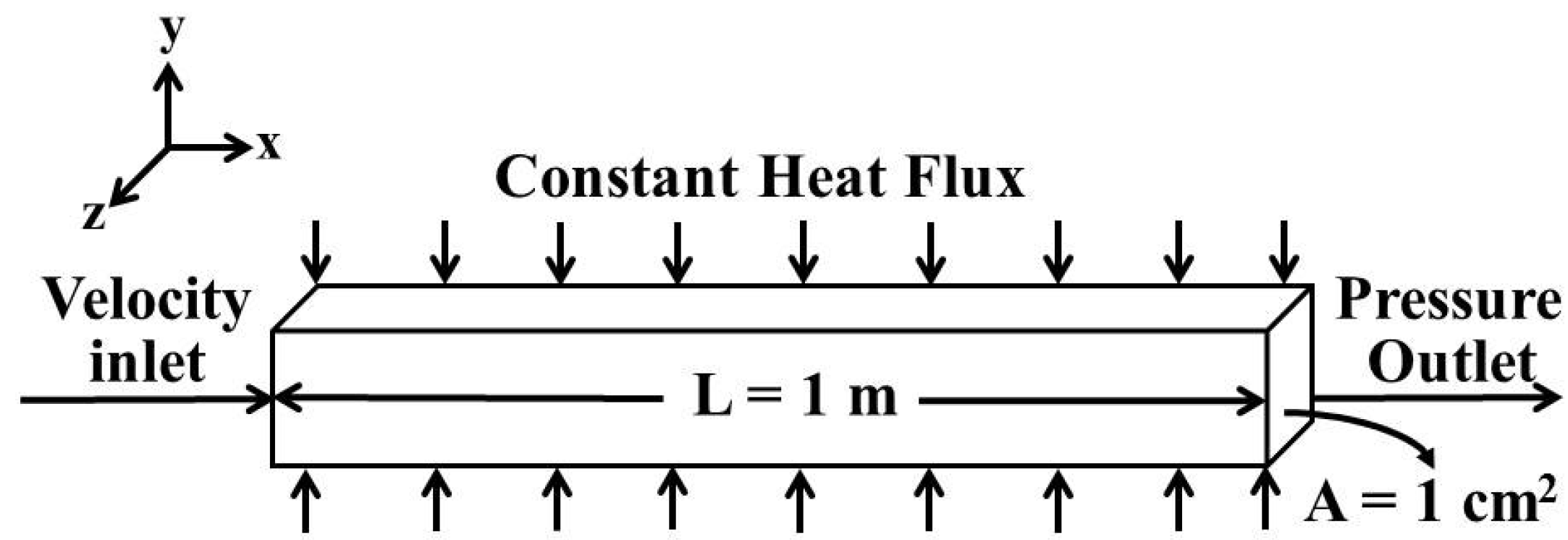
3. Results and Discussion
3.1. Grid-Independence Analysis
3.2. Validation
3.3. Effects of Peclet Number and Particle Volume Concentrations
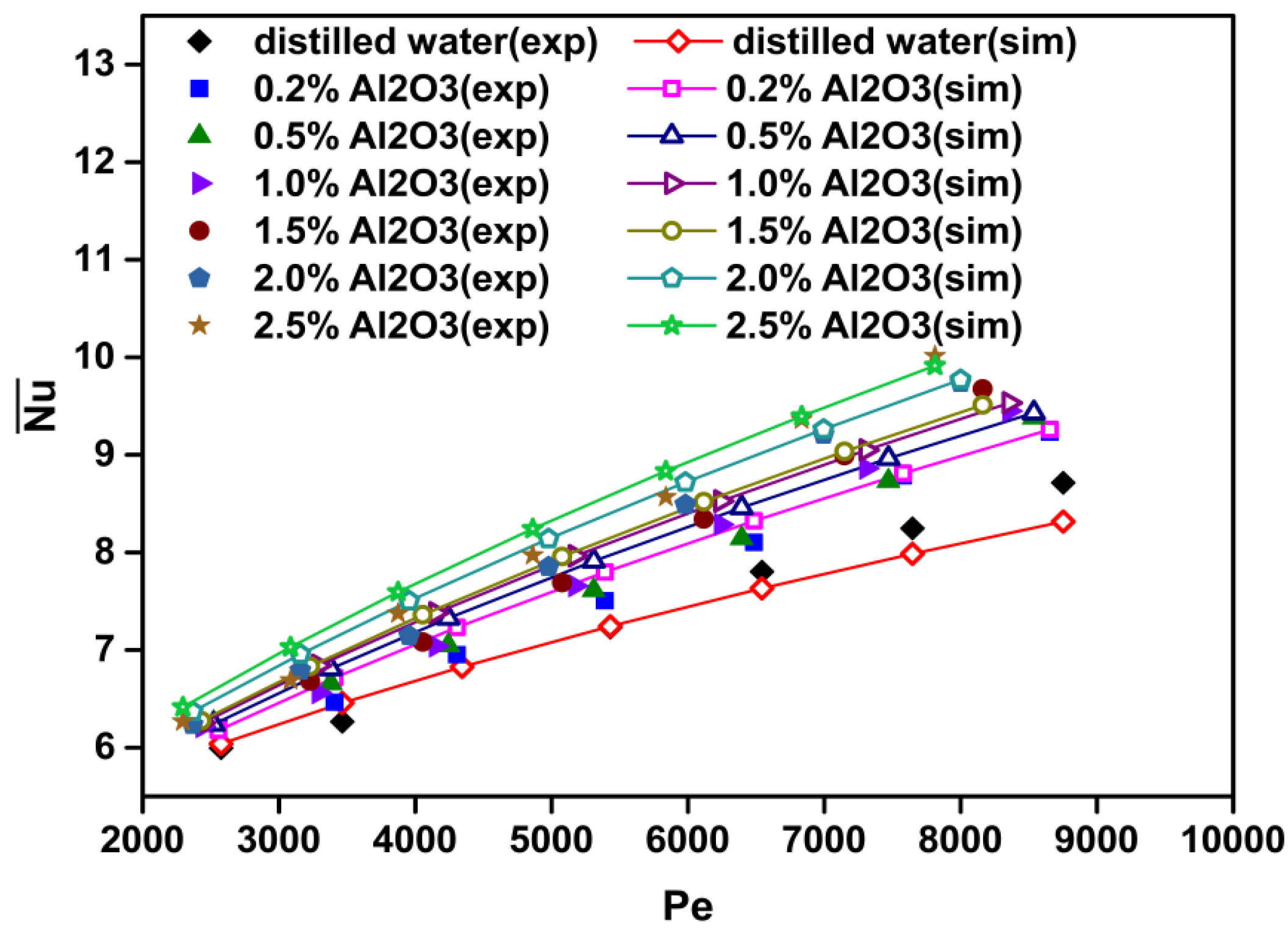
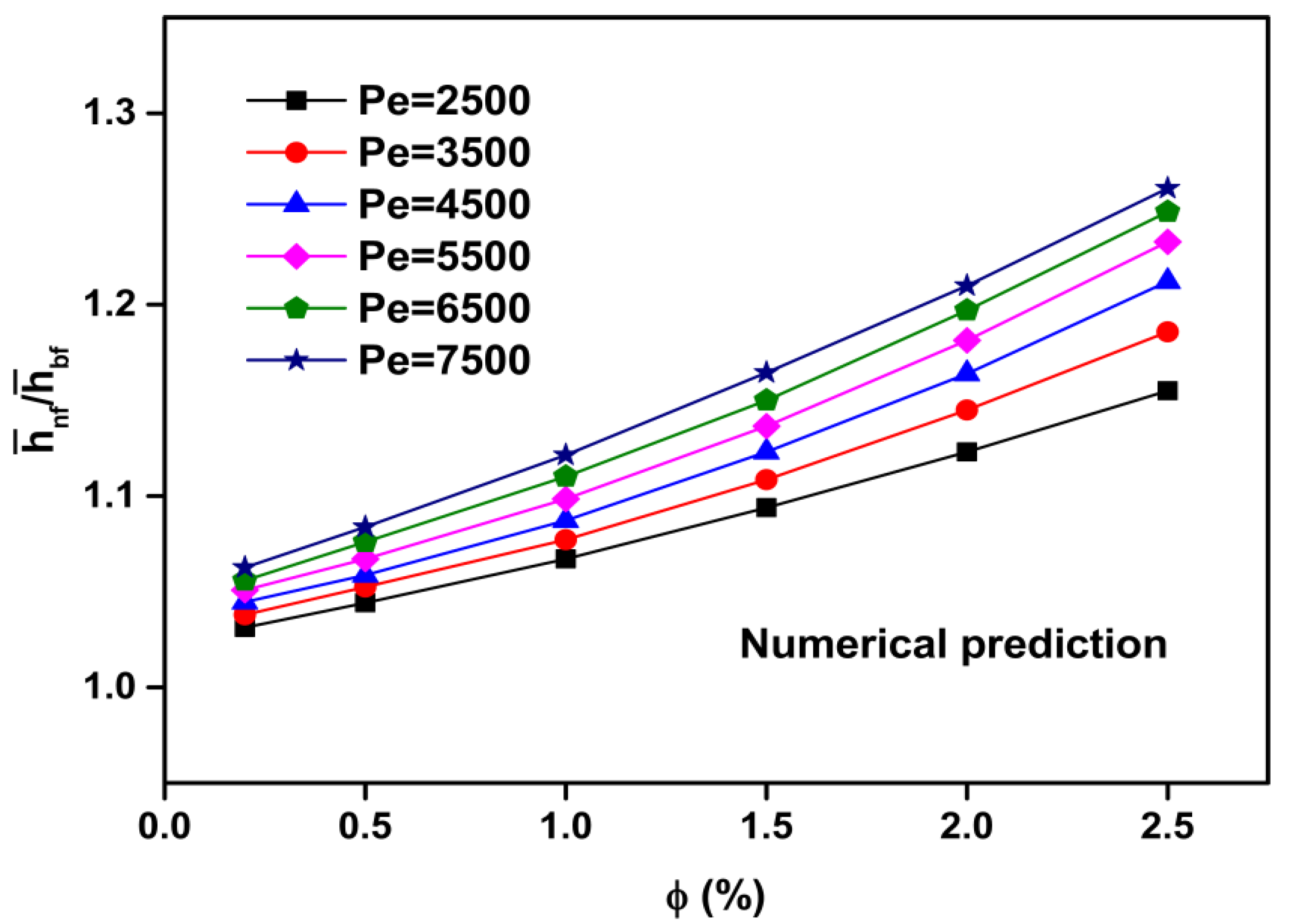
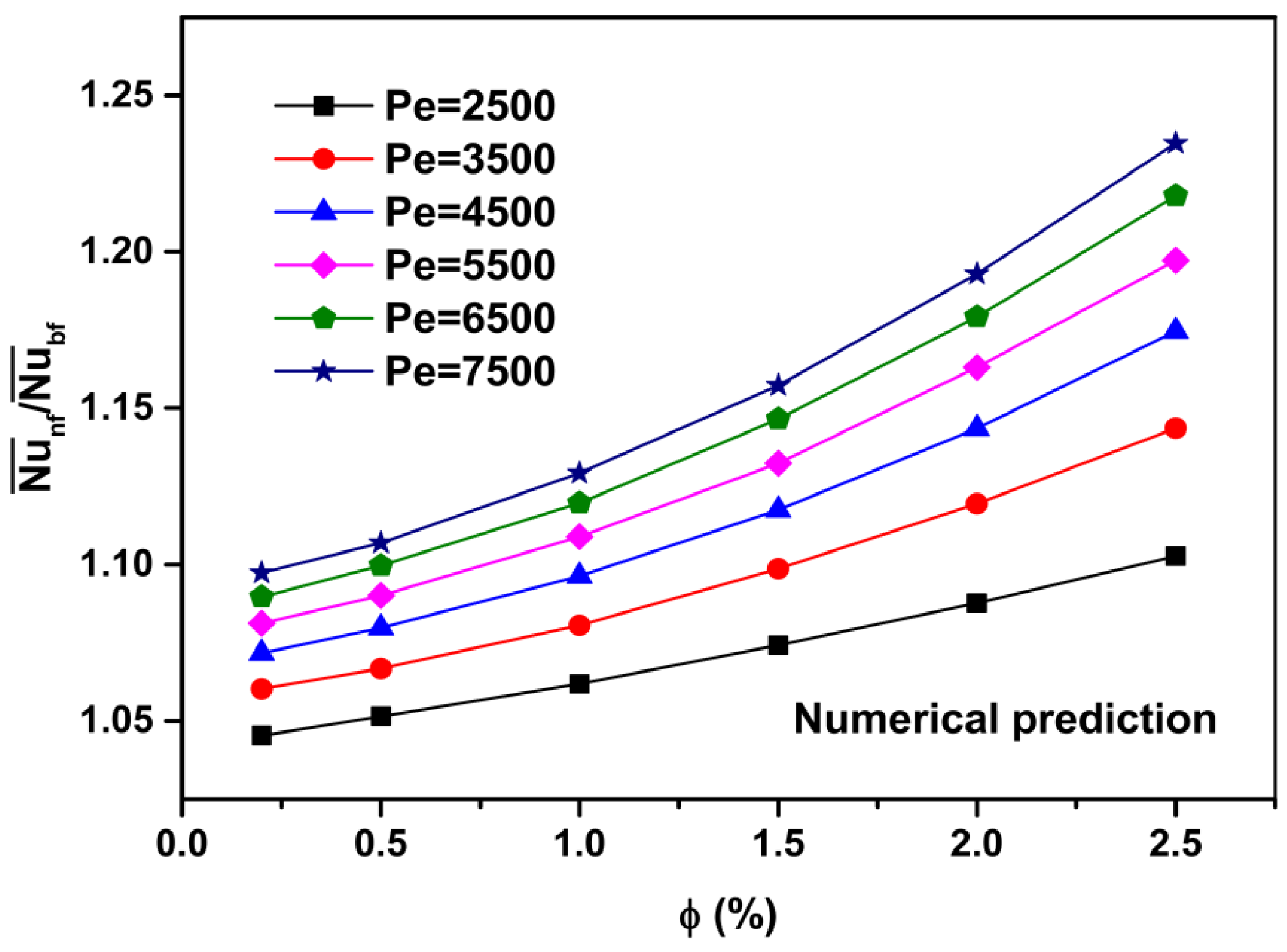


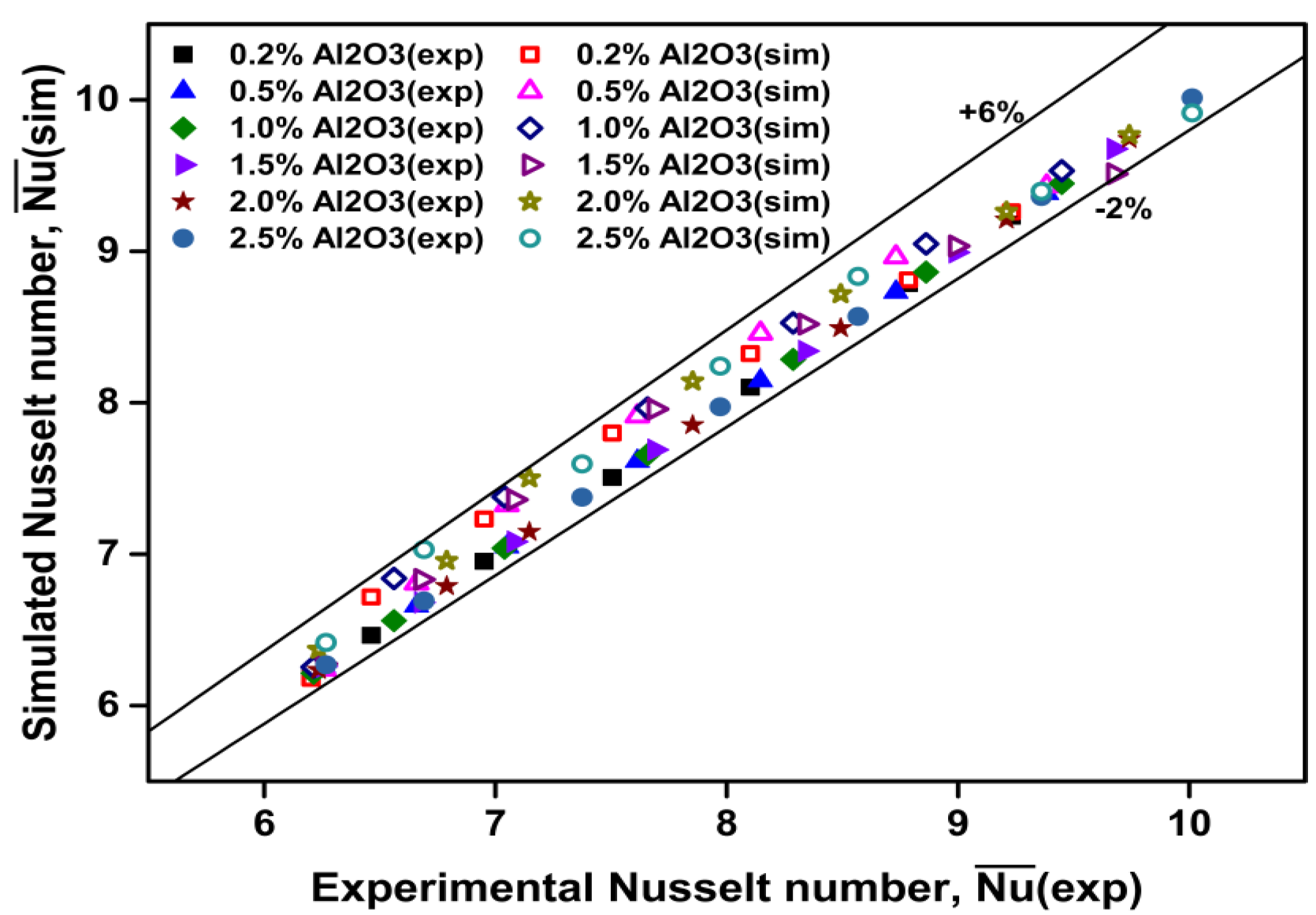


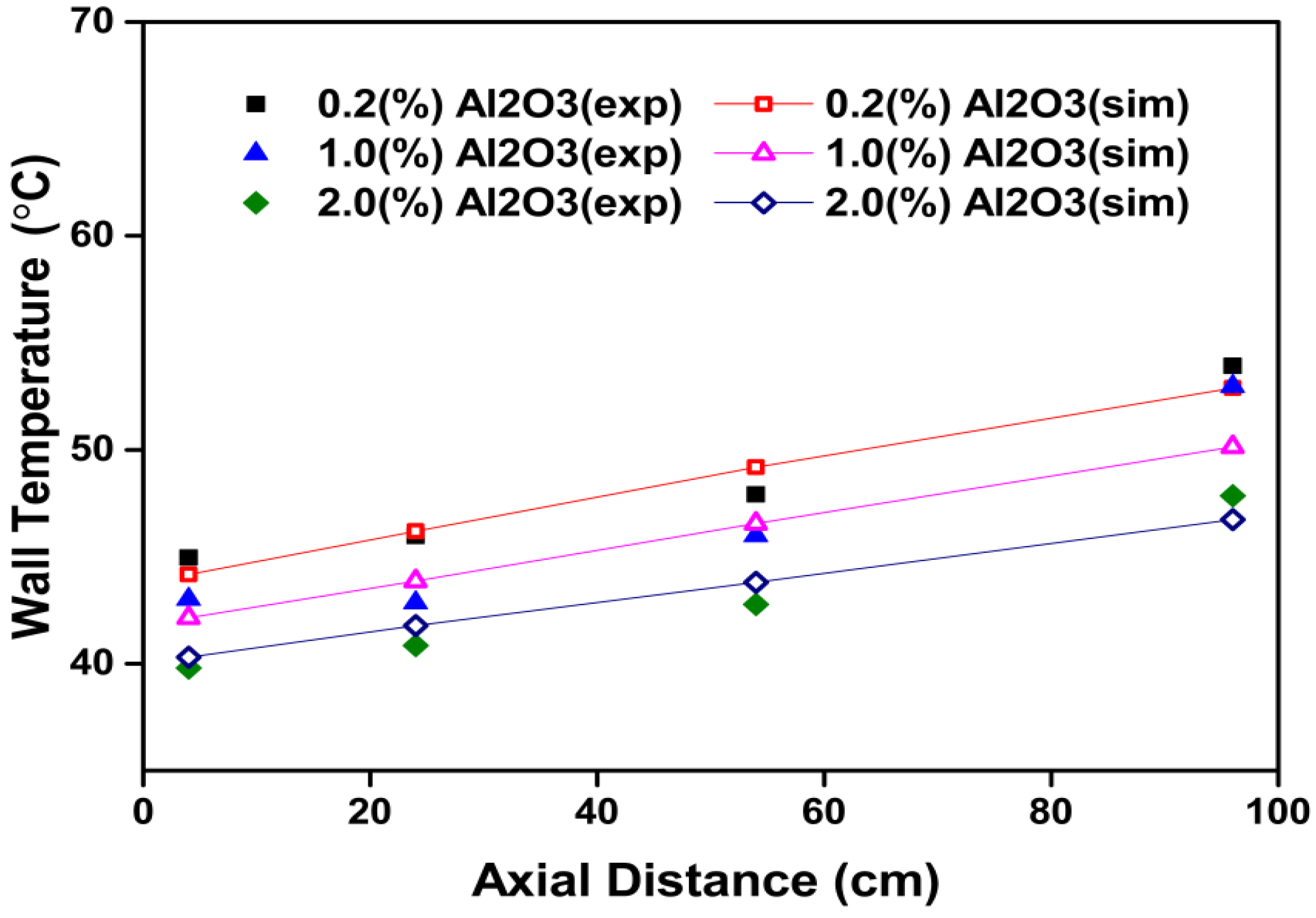
4. Conclusions
Acknowledgments
Author Contributions
Conflicts of Interest
Nomenclature
Surface area of square cross-section duct (m2) | |
| C | Specific heat (kJ·kg–1·K–1) |
| Dh | Hydraulic diameter (m) |
Experimental average nanofluid heat transfer coefficient (W·m–2·K–1) | |
Simulated average nanofluid heat transfer coefficient (W·m–2·K–1) | |
Theoretical average nanofluid heat transfer coefficient (W·m–2·K–1) | |
| k | Thermal conductivity (W·m–1·K–1) |
| L | Duct length (m) |
Average nanofluid Nussult number obtained from experiments | |
Average nanofluid Nussult number calculated from CFD analysis | |
| Pe | Peclet number |
| Pr | Prandtl number |
| q | Heat flux (W/m2) |
| Re | Reynolds number |
| Tb | Bulk temperature (K) |
| Tw | Duct wall temperature (K) |
Average fluid velocity (m·s–1) | |
| u | The x-component of the velocity (m·s–1) |
| v | The y-component of the velocity (m·s–1) |
| w | The z-component of the velocity (m·s–1) |
Greek Symbols
| γ | Ratio of the nano-layer thickness to original particle radius |
| μ | Viscosity (Pa·s) |
| μwnf | Nanofluid viscosity at duct wall temperature (Pa·s) |
| ϕ | Nanoparticle volume fraction (%) |
| ρ | Density (kg·m–3) |
Subscripts
| bf | Base fluid |
| i | Inlet |
| nf | Nanofluid |
| o | Outlet |
| p | Solid nanoparticles |
| w | Wall |
References
- Bianco, V.; Manca, O.; Nardini, S. Second law analysis of Al2O3-water nanofluid turbulent forced convection in a circular cross section tube with constant wall temperature. Adv. Mech. Eng. 2013, 2013, 1–12. [Google Scholar] [CrossRef]
- Bianco, V.; Manca, O.; Nardini, S. Performance analysis of turbulent convection heat transfer of Al2O3 water-nanofluid in circular tubes at constant wall temperature. Energy 2014, 77, 403–413. [Google Scholar] [CrossRef]
- Lee, S.; Choi, S.U.S.; Li, S.; Eastman, J.A. Measuring thermal conductivity of fluids containing oxide Nanoparticles. J. Heat Transf. 1999, 121, 280–289. [Google Scholar] [CrossRef]
- Mostafizur, R.M.; Saidur, R.; Abdul Aziz, A.R.; Bhuiyan, M.H.U. Thermophysical properties of methanol based Al2O3 nanofluids. Int. J. Heat Mass Transf. 2015, 85, 414–419. [Google Scholar] [CrossRef]
- Choi, S.U.S.; Zhang, Z.G.; Lockwood, F.E.; Grulke, E.A. Anomalous thermal conductivity enhancement in nanotube suspensions. Appl. Phys. Lett. 2001, 79, 2252–2254. [Google Scholar] [CrossRef]
- Ellahi, R.; Hassan, M.; Zeeshan, A. Shape effects of nanosize particles in Cu-H2O nanofluid on entropy generation. Int. J. Heat Mass Transf. 2015, 81, 449–456. [Google Scholar] [CrossRef]
- Sheikholeslami, M.; Ellahi, R.; Hassan, M.; Soleimani, S. A study of natural convection heat transfer in a nanofluid filled enclosure with elliptic inner cylinder. Int. J. Numer. Methods Heat Fluid Flow 2014, 24, 1906–1927. [Google Scholar] [CrossRef]
- Sheikholeslami, M.; Ellahi, R.; Ashorynejad, H.R.; Domairry, G.; Hayat, T. Effects of heat transfer in flow of nanofluids over a permeable stretching wall in a porous medium. J. Comput. Theor. Nanosci. 2014, 11, 486–496. [Google Scholar] [CrossRef]
- Akbar, N.S.; Raza, M.; Ellahi, R. Interaction of nano particles for the peristaltic flow in an asymmetric channel with the induced magnetic field. Eur. Phys. J. Plus 2014, 129, 155–167. [Google Scholar] [CrossRef]
- Akbar, N.S.; Raza, M.; Ellahi, R. Influence of heat generation and heat flux on peristaltic flow with interacting nanoparticles. Eur. Phys. J. Plus 2014, 129. [Google Scholar] [CrossRef]
- Sheikholeslami, M.; Bandpy, M.G.; Ellahi, R.; Zeeshan, A. Simulation of MHD CuO-water nanofluid flow and convective heat transfer considering Lorentz forces. J. Magn. Magn. Mater. 2014, 369, 69–80. [Google Scholar] [CrossRef]
- Ding, Y.L.; Alias, H.; Wen, D.S.; Williams, R.A. Heat transfer of aqueous suspensions of carbon nanotubes (CNT nanofluids). Int. J. Heat Mass Transf. 2006, 49, 240–250. [Google Scholar] [CrossRef]
- Wen, D.; Ding, Y. Experimental investigation into convective heat transfer of nanofluids at the entrance region under laminar flow conditions. Int. J. Heat Mass Transf. 2004, 47, 5181–5188. [Google Scholar] [CrossRef]
- Heris, S.Z.; Etemad, S.G.; Esfahany, M.N. Experimental investigation of oxide nanofluids laminar flow convective heat transfer. Int. Commun. Heat Mass Transf. 2006, 33, 529–535. [Google Scholar] [CrossRef]
- Heris, S.Z.; Esfahnany, M.N.; Etemad, S.G. Numerical investigation of nanofluid laminar convective heat transfer through a circular tube. Numer. Heat Transf. Part A 2007, 52, 1043–1058. [Google Scholar] [CrossRef]
- Mirmasoumi, S.; Behzadmehr, A. Numerical study of laminar mixed convection of a nanofluid in a horizontal tube using two-phase mixture model. Appl. Therm. Eng. 2008, 28, 717–727. [Google Scholar] [CrossRef]
- Shahi, M.; Mahmoudi, A.H.; Talebi, F. Numerical study of mixed convective cooling in a square cavity ventilated and partially heated from the below utilizing nanofluid. Int. Commun. Heat Mass Transf. 2010, 37, 201–213. [Google Scholar] [CrossRef]
- Mohammed, H.A.; Bhaskaran, G.; Shualib, N.H.; Abu-Mulaweh, H.I. Influence of nanofluids on parallel flow square microchannel heat exchanger performance. Int. Commun. Heat Mass Transf. 2011, 38, 1–9. [Google Scholar] [CrossRef]
- Mohammed, H.A.; Bhaskaran, G.; Shualib, N.H.; Saidur, R. Numerical study of heat transfer enhancement of counter flow of nanofluids in rectangular microchannel heat exchanger. Superlattices Microstruct. 2011, 50, 215–233. [Google Scholar] [CrossRef]
- Sheikholeslami, M.; Ganji, D.D.; Javed, M.Y.; Ellahi, R. Effect of thermal radiation on nanofluid flow and heat transfer using two phase model. J. Magn. Magn. Mater. 2015, 374, 36–43. [Google Scholar] [CrossRef]
- Rashidi, S.; Dehghan, M.; Ellahi, R.; Riaz, M.; Jamal-Abad, M.T. Study of stream wise transverse magnetic fluid flow with heat transfer around a porous obstacle. J. Magn. Magn. Mater. 2015, 378, 128–137. [Google Scholar] [CrossRef]
- Zeeshan, A.; Ellahi, R.; Hassan, M. Magnetohydrodynamic flow of water/ethylene glycol based nanofluids with natural convection through porous medium. Eur. Phys. J. Plus 2014, 129. [Google Scholar] [CrossRef]
- Ellahi, R.; Aziz, S.; Zeeshan, A. Nano fluid flow in tapering stenosed arteries with permeable walls. Int. J. Therm. Sci. 2014, 85, 54–61. [Google Scholar]
- Ellahi, R.; Aziz, S.; Zeeshan, A. Non-Newtonian nanofluids flow through a porous medium between two coaxial cylinders with heat transfer and variable viscosity. J. Porous Media 2013, 16, 205–216. [Google Scholar] [CrossRef]
- Ellahi, R. The effects of MHD and temperature dependent viscosity on the flow of non-Newtonian nanofluid in a pipe: analytical solutions. Appl. Math. Model. 2013, 37, 1451–1457. [Google Scholar] [CrossRef]
- Ellahi, R.; Raza, M.; Vafai, K. Series solutions of non-Newtonian nanofluids with Reynolds’ model and Vogel’s model by means of the homotopy analysis method. Math. Comput. Model. 2012, 55, 1876–1891. [Google Scholar] [CrossRef]
- Heris, S.Z.; Nassan, T.H.; Noie, S.H.; Sardarabadi, H.; Sardarabadi, M. Laminar convective heat transfer of Al2O3/water nanofluid through square cross-sectional duct. Int. J. Heat Fluid Flow 2013, 44, 375–382. [Google Scholar] [CrossRef]
- Koo, J.; Kleinstreuer, C. Laminar nanofluid flow in microheat-sinks. Int. J. Heat Mass Transf. 2005, 48, 2652–2661. [Google Scholar] [CrossRef]
- Santra, A.K.; Sen, S.; Chakraborty, N. Study of heat transfer due to laminar flow of copper-water nanofluid through two isothermally heated parallel plates. Int. J. Therm. Sci. 2009, 48, 391–400. [Google Scholar] [CrossRef]
- Yu., W.; Choi, S.U.S. The role of interfacial layers in the enhanced thermal of nanofluids: A renovated Maxwell model. J. Nanopart. Res. 2003, 5, 167–171. [Google Scholar] [CrossRef]
- ANSYS FLUENT Workbench User’s Guide; Release 12.1; ANSYS, Inc.: Cecil Township, Washington County, PA, USA, 2009.
- Sieder, E.N.; Tate, G.E. Heat transfer and pressure drop of liquid in tubes. Ind. Eng. Chem. 1936, 28, 1429–1435. [Google Scholar] [CrossRef]
- Xuan, Y.; Li, Q. Heat transfer enhancement of nanofluids. Int. J. Heat Fluid Flow 2000, 21, 58–64. [Google Scholar] [CrossRef]
- Wen, D.; Ding, Y. Effect of particle migration on heat transfer in suspensions of nanoparticles flowing through minichannels. Microfluid. Nanofluid. 2005, 1, 183–189. [Google Scholar] [CrossRef]
- Heyhat, M.M.; Kowsary, F. Effect of particle migration on flow and convective heat transfer of nanofluids flowing through a circular pipe. J. Heat Trans. ASME 2010, 132, 062401:1–062401:9. [Google Scholar] [CrossRef]
- Pak, B.C.; Cho, Y.I. Hydrodynamic and heat transfer study of dispersed fluids with submicron metallic oxide particles. Exp. Heat Transf. 1998, 11, 151–170. [Google Scholar] [CrossRef]
© 2015 by the authors; licensee MDPI, Basel, Switzerland. This article is an open access article distributed under the terms and conditions of the Creative Commons Attribution license (http://creativecommons.org/licenses/by/4.0/).
Share and Cite
Ting, H.-H.; Hou, S.-S. Investigation of Laminar Convective Heat Transfer for Al2O3-Water Nanofluids Flowing through a Square Cross-Section Duct with a Constant Heat Flux. Materials 2015, 8, 5321-5335. https://doi.org/10.3390/ma8085246
Ting H-H, Hou S-S. Investigation of Laminar Convective Heat Transfer for Al2O3-Water Nanofluids Flowing through a Square Cross-Section Duct with a Constant Heat Flux. Materials. 2015; 8(8):5321-5335. https://doi.org/10.3390/ma8085246
Chicago/Turabian StyleTing, Hsien-Hung, and Shuhn-Shyurng Hou. 2015. "Investigation of Laminar Convective Heat Transfer for Al2O3-Water Nanofluids Flowing through a Square Cross-Section Duct with a Constant Heat Flux" Materials 8, no. 8: 5321-5335. https://doi.org/10.3390/ma8085246





